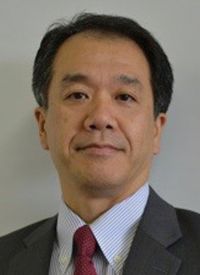S-1 Shows Significant Improvement in iDFS for HR+, HER2-Breast Cancer
Japanese patients with HR-positive, HER2-negative breast cancer had a significant improvement in invasive disease-free survival with the addition of the novel oral fluoropyrimidine derivative S-1, according to findings from the phase III POTENT trial presented at the 2019 San Antonio Breast Cancer Symposium.
Masakazu Toi, MD, PhD

Masakazu Toi, MD, PhD
Japanese patients with HR-positive, HER2-negative breast cancer had a significant improvement in invasive disease-free survival (iDFS) with the addition of the novel oral fluoropyrimidine derivative S-1 (Teysuno), according to findings from the phase III POTENT trial presented at the 2019 San Antonio Breast Cancer Symposium (SABCS).
At a median follow-up of 51.4 months, 10.6% of patients assigned to S-1 experienced disease recurrence compared with 15.9% for those assigned to endocrine therapy alone (HR, 0.63; 95% CI, 0.49-0.81; P <.001). Investigators recorded 101 iDFS events in the S-1 arm compared with 155 in the control arm. S-1 was also associated with an improved estimated 5-year iDFS rate (86.9% vs 81.6%).1
Masakazu Toi, MD, PhD, professor of breast surgery at Kyoto University Hospital, presented the results during a press briefing Wednesday morning. The trial was stopped early because it met the primary endpoint for iDFS ahead of schedule.
“Although we have made remarkable progress with systemic therapy for breast cancer, many patients still experience disease recurrence,” he said in a news release. “We found that the postoperative adjuvant use of S-1 in combination with standard endocrine therapy significantly reduced iDFS events and improved 5-year iDFS estimates in patients with HR-positive and HER2-negative breast cancer.”
Approximately 67% of patients with breast cancer have HR-positive, HER2-negative disease. The prognosis is good for this population, 4-year disease-specific survival is 92.5%. However, this disease subtype is associated with late recurrence, and recurrent disease is generally incurable.2 Toi and his colleagues sought to identify a novel post-operative adjuvant therapy that can be used in conjunction with endocrine therapy to reduce the risk for recurrence.
Investigators recruited 1932 patients with stage I-III HR-positive, HER2-negative breast cancer with intermediate or higher risk for recurrence at 139 medical centers in Japan. Patients were randomly assigned to S-1 plus endocrine therapy (n = 954) or endocrine therapy alone (n = 970) in the adjuvant, postoperative setting.
Patients were assigned to daily S-1 at 80 mg, 100 mg, or 120 mg according to body surface area and received the drug on a 2 weeks on/1 week off schedule for 1 year.
S-1 is a combination drug composed of tegafur, a 5-fluorouracil prodrug that inhibits DNA synthesis and cell division; gimeracil, which promotes tegafur activity; and oteracil to prevent gastrointestinal toxicity. Previous studies have shown that combining tegafur with endocrine therapy can improve antitumor efficacy. Data published in 2018 showed that adding tegafur/uracil to treatment with anastrozole resulted in significantly greater tumor shrinkage compared with anastrozole alone for postmenopausal Japanese women with ER-positive, HER2-negative disease (31.0% vs 14.2%; P = 0.018).3
The safety profile was “quite manageable,” Toi said. The most common ³3 adverse events in the S-1 arm were neutrophil decreased (7.5%) and diarrhea (1.9%) compared with 0.7% and 0% in the control arm, respectively.
Toi noted that POTENT only included patients from Japan and the findings may not translate to another population. He added that Asian and non-Asian patients would likely have a different toxicity profile.
Furthermore, the FDA has not approved S-1 in the United States. Session moderator Carlos Arteaga, MD, SABCS codirector and director of the Harold C. Simmons Comprehensive Cancer Center at the University of Texas Southwestern Medical Center, said physicians in the U.S. would assign a patient with HR-positive, HER2-negative to chemotherapy depending on the individual’s risk for recurrence.
References
- Toi M, Imoto S, Ishida T, et al. Addition of S-1 to endocrine therapy in the post-operative adjuvant treatment of hormone receptor-positive and human epidermal growth factor receptor 2-negative primary breast cancer: A multicenter, open-label, phase 3 randomized trial. (POTENT trial). Presented at: the 2019 San Antonio Breast Cancer Symposium; December 10-14, 2019; San Antonio, Tx. Abstract GS1-09. Lefebvre C, Bachelot T, Filleron T, et al. Mutational profile of metastatic breast cancers: a retrospective analysis.PLoS Med.2016;13(12):e1002201. doi: 10.1371/journal.pmed.1002201.
- Yamamura J, Kamigaki S, Tsujie M, et al. Response to first-line recurrence treatment influences survival in hormone receptor-positive, HER2-negative breast cancer: a multicenter study. In Vivo. 2019;33(1): 281287. doi: 10.21873/invivo.11473.
- Nakayama T, Yasuaki Sagara Y, Takashima T, et al. Randomized phase II study of anastrozole plus tegafur-uracil as neoadjuvant therapy for ER-positive breast cancer in postmenopausal Japanese women (Neo-ACET BC). Cancer Chemother Pharmacol. 2018;81(4):755762. doi: 10.1007/s00280-018-3544-5.
Batalini Explores Role of UGT1A1 in Patients Treated With Sacituzumab Govitecan for HR+ MBC
April 22nd 2024During a Community Case Forum live event in partnership with The Arizona Clinical Oncology Society, Felipe Batalini, MD, discussed the TROPiCS-02 trial of sacituzumab govitecan and the impact of the UGT1A1 status on adverse event frequency.
Read More
Breast Cancer Leans into the Decade of Antibody-Drug Conjugates, Experts Discuss
September 25th 2020In season 1, episode 3 of Targeted Talks, the importance of precision medicine in breast cancer, and how that vitally differs in community oncology compared with academic settings, is the topic of discussion.
Listen